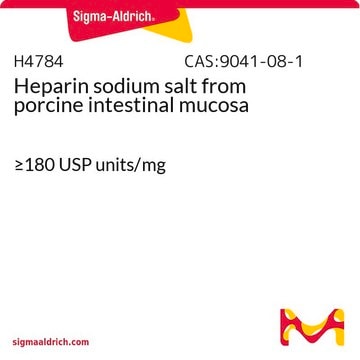H7640
Heparan sulfate sodium salt from bovine kidney
powder, extracellular matrix component
Synonym(s):
Heparitin sulfate sodium salt
About This Item
Recommended Products
Looking for similar products? Visit Product Comparison Guide
Application
- to investigate its effect on proliferation of B cells
- to monitor its role on eye development in E5 embryonic cells
- to study its binding with exosome fibronectin in human trabecular meshwork cells using dot blot
Biochem/physiol Actions
Storage Class Code
11 - Combustible Solids
WGK
WGK 3
Flash Point(F)
Not applicable
Flash Point(C)
Not applicable
Personal Protective Equipment
Certificates of Analysis (COA)
Search for Certificates of Analysis (COA) by entering the products Lot/Batch Number. Lot and Batch Numbers can be found on a product’s label following the words ‘Lot’ or ‘Batch’.
Already Own This Product?
Find documentation for the products that you have recently purchased in the Document Library.
Customers Also Viewed
Articles
Uncover more about glycosaminoglycans and proteoglycans including the structure of glycosaminoglycans (GAGs), the different types of GAGs, and their functions.
Glycosaminoglycans are large linear polysaccharides constructed of repeating disaccharide units.
Our team of scientists has experience in all areas of research including Life Science, Material Science, Chemical Synthesis, Chromatography, Analytical and many others.
Contact Technical Service









